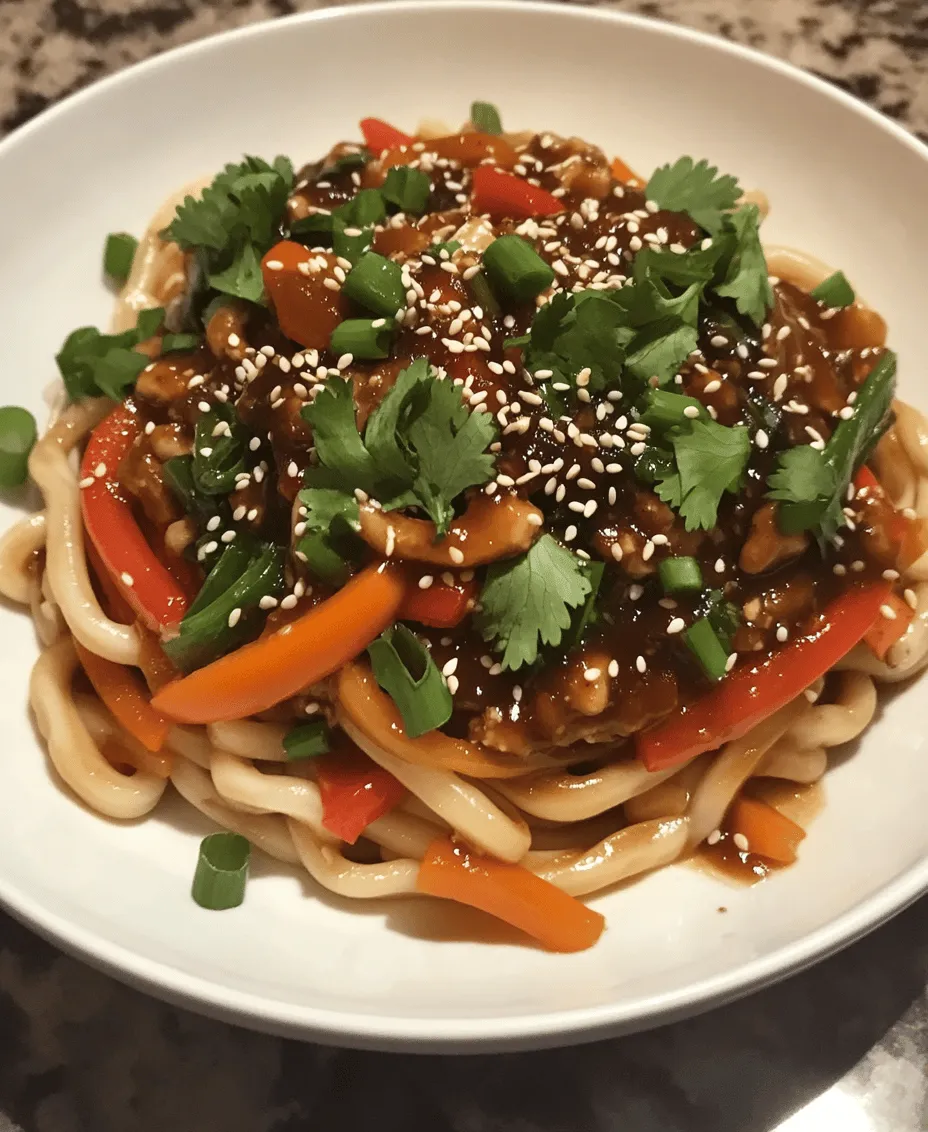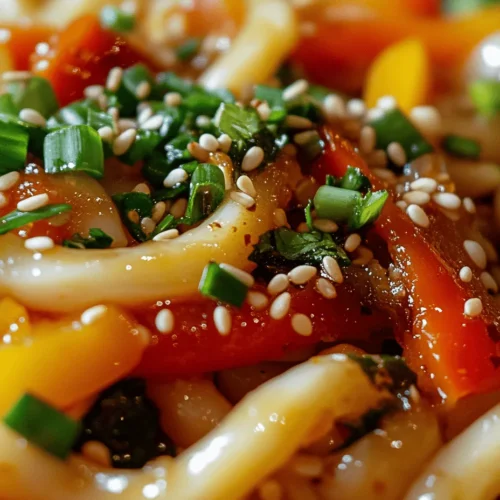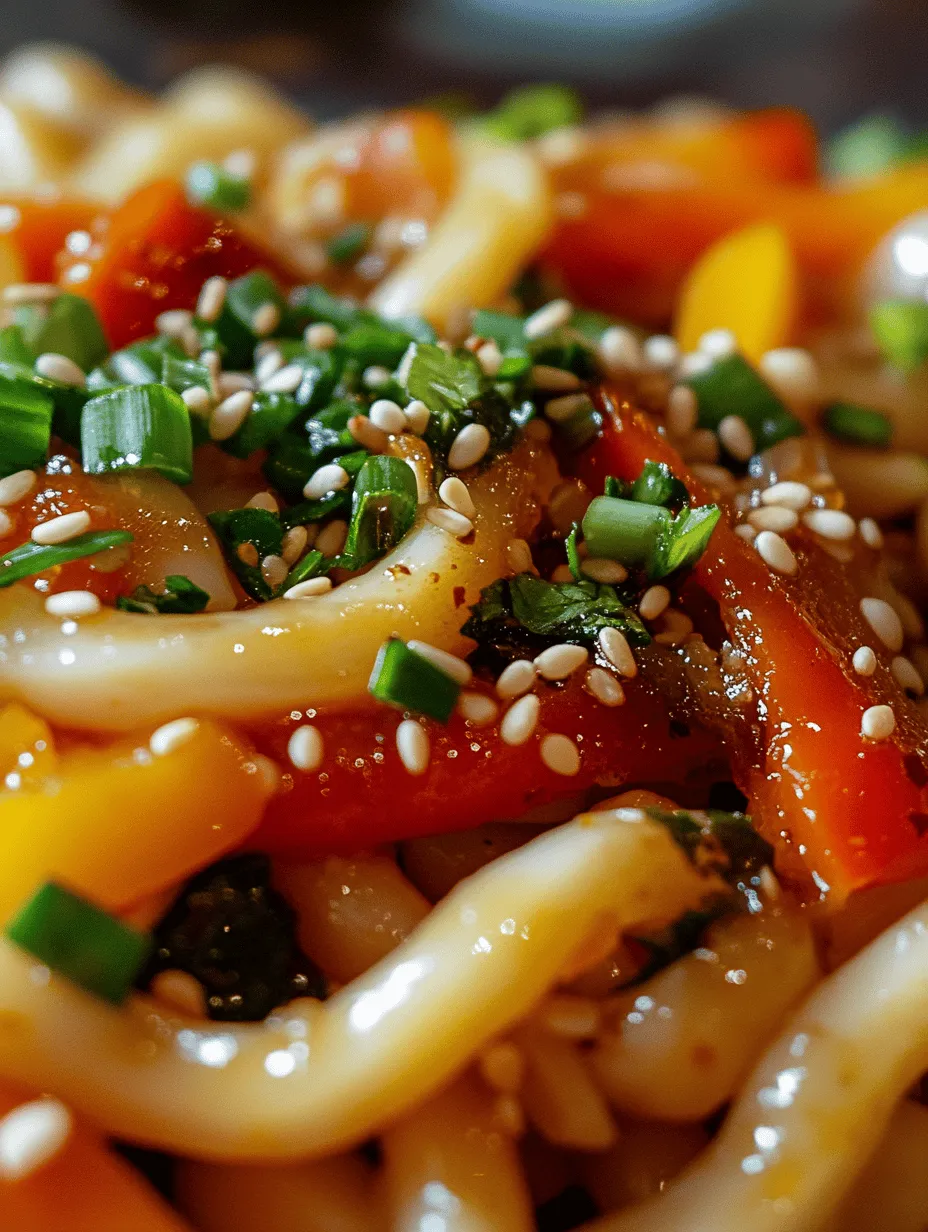In the fast-paced world we live in today, finding time to create a delicious and satisfying meal can be a challenge. However, with our 10-Minute Chili Oil Udon Noodles, you can indulge in a bowl of comforting goodness without sacrificing flavor or quality. This recipe is perfect for busy weeknights or a quick lunch, combining the perfect balance of spice, freshness, and umami that will surely please your palate. With just a handful of ingredients and minimal preparation, both novice cooks and seasoned chefs can whip up this delightful dish in no time.
Udon noodles are the star of this recipe, renowned for their thick, chewy texture that pairs beautifully with a variety of sauces and ingredients. In this article, we’ll delve into the origins of udon noodles, their significance in Japanese cuisine, and guide you through each step of the recipe, including tips for customization to suit your taste preferences.
Understanding Udon Noodles
Udon Noodles: A Brief Overview
Originating from Japan, udon noodles have become a staple in Japanese cuisine, celebrated for their versatility and satisfying texture. Made primarily from wheat flour, water, and salt, these noodles are thick and chewy, making them a perfect canvas for a wide array of flavors and sauces. Traditionally served in a savory broth or stir-fried with vegetables and meats, udon noodles have earned their place in both casual home cooking and high-end restaurants alike.
In the market, you’ll find several types of udon noodles, including fresh, frozen, and dried varieties. Fresh udon noodles are soft and have a slightly higher moisture content, providing a delightful chewiness when cooked. Frozen udon offers the convenience of quick preparation while retaining much of the fresh flavor. Dried udon noodles, on the other hand, are shelf-stable and can be stored for extended periods, making them a great pantry staple. When selecting udon noodles for this recipe, consider your preference for texture and availability.
Cooking Techniques for Udon Noodles
To achieve the perfect texture with udon noodles, it’s essential to follow best practices during cooking. Start by boiling a large pot of water. The general rule of thumb is to use about 4-6 cups of water for every serving of noodles. Once the water reaches a rolling boil, add the udon noodles and stir gently to prevent them from sticking together.
Cooking times vary depending on the type of udon you choose; fresh noodles typically require just 2-3 minutes, while dried noodles may take around 8-10 minutes. It’s crucial to taste the noodles a minute or two before the recommended cooking time is up to ensure they reach the ideal al dente texture.
After cooking, don’t forget to rinse and cool the noodles under cold running water. This step not only halts the cooking process but also removes excess starch, preventing the noodles from becoming gummy. Properly rinsed and cooled udon noodles will provide a delightful chewiness that enhances the overall dish.
Ingredients Breakdown for Chili Oil Udon Noodles
Essential Ingredients
To create this mouthwatering 10-Minute Chili Oil Udon Noodles, you’ll need a few essential ingredients that come together to create an explosion of flavors. Here’s a breakdown of each ingredient and its role in the recipe:
1. Udon Noodles: The base of the dish, udon noodles add heartiness and texture.
2. Chili Oil: The star ingredient, chili oil infuses the dish with heat and depth. (More on this later!)
3. Soy Sauce: A staple in Asian cuisine, soy sauce adds a savory umami flavor that complements the noodles beautifully.
4. Sesame Oil: A drizzle of sesame oil adds a nutty aroma and richness to the dish.
5. Garlic: Fresh garlic provides a pungent flavor that enhances the overall taste of the dish.
6. Ginger: Using fresh ginger adds a zesty kick that pairs well with the other ingredients.
7. Vegetables: Common additions include scallions, bell peppers, or snap peas, offering freshness and texture.
8. Protein (Optional): If you desire, you can add proteins such as tofu, shrimp, or chicken for a more filling meal.
In addition to the delightful flavors, this meal is packed with nutritional benefits. Udon noodles are rich in carbohydrates, providing energy for your day. Vegetables add essential vitamins and minerals, while the inclusion of protein can promote muscle health and satiety.
Chili Oil: The Star Ingredient
Chili oil is not just an ingredient; it’s a flavor powerhouse that elevates this dish to new heights. Made by infusing oil with dried chili flakes, garlic, and sometimes spices like Sichuan peppercorns, chili oil offers a complex flavor profile that ranges from spicy to smoky, depending on its preparation.
When it comes to adjusting spice levels, this is where you can customize the recipe to suit your taste. If you prefer a milder flavor, use less chili oil or mix in a neutral oil like vegetable oil to dilute the heat. On the other hand, if you crave a fiery kick, feel free to add more chili oil or even incorporate fresh chili peppers for an extra punch.
The Role of Aromatics
No dish is complete without aromatics, and in this recipe, garlic and ginger play crucial roles in enhancing the flavor. Fresh garlic adds a pungent, savory note, while ginger introduces a warm, zesty undertone. Together, they create a fragrant foundation for the udon noodles.
When choosing between fresh and pre-minced ingredients, fresh garlic and ginger are highly recommended for their vibrant flavors. If you’re pressed for time, however, pre-minced options can work in a pinch. Just be aware that they may not offer the same depth of flavor as their fresh counterparts.
Step-by-Step Cooking Guide
Preparing the Udon Noodles
Now that you’ve gathered all your ingredients, it’s time to prepare the udon noodles. Follow these detailed instructions to ensure perfect results:
1. Boil Water: Fill a large pot with water and bring it to a rolling boil over high heat.
2. Add Udon Noodles: Once boiling, add the udon noodles to the pot. Stir gently to separate them and prevent sticking.
3. Cook the Noodles: Refer to the package instructions for cooking time—fresh noodles typically take 2-3 minutes, while dried noodles may take 8-10 minutes. Stir occasionally to ensure even cooking.
4. Taste for Doneness: As the cooking time approaches, taste a noodle to check for texture. It should be tender yet firm to the bite.
5. Rinse and Cool: Once cooked, drain the noodles in a colander and rinse under cold running water. This step is essential for achieving the perfect noodle texture, as it prevents the noodles from becoming gummy.
6. Set Aside: Allow the rinsed noodles to drain completely while you prepare the sauce and aromatics.
Crafting the Flavorful Sauce
The next step is to mix the sauce that will coat your udon noodles and bring the dish to life. Here’s how to do it:
1. Combine Ingredients: In a bowl, mix together the chili oil, soy sauce, and sesame oil. Adjust the quantities according to your taste preference—more chili oil for spice, or more soy sauce for saltiness.
2. Whisk Together: Use a whisk or fork to combine the ingredients thoroughly, ensuring a well-blended sauce that will coat the noodles evenly.
3. Taste and Adjust: Before adding to the noodles, taste the sauce and make any necessary adjustments. If it’s too spicy, add a bit more soy sauce; if it needs more heat, incorporate additional chili oil.
Sautéing Aromatics and Vegetables
Finally, it’s time to sauté the aromatics and vegetables that will complement the udon noodles beautifully:
1. Heat Oil: In a large skillet or wok, heat a tablespoon of oil over medium heat. Use an oil with a high smoke point, such as vegetable oil or canola oil.
2. Add Garlic and Ginger: Once the oil is hot, add minced garlic and ginger to the skillet. Sauté for about 30 seconds until fragrant, being careful not to burn them.
3. Incorporate Vegetables: Add your choice of chopped vegetables, such as sliced bell peppers, snap peas, or scallions. Stir-fry for 2-3 minutes until they are tender yet still crisp.
4. Combine with Noodles: Once the vegetables are cooked, add the rinsed udon noodles to the skillet along with the prepared sauce. Toss everything together to coat the noodles and vegetables in the flavorful sauce.
With these initial steps completed, you are well on your way to enjoying a bowl of delicious 10-Minute Chili Oil Udon Noodles. Stay tuned for the next part of this article, where we will delve into additional cooking tips, customization options, and common questions to elevate your cooking experience.

Step-by-Step Guide for Sautéing Garlic, Ginger, and Mixed Vegetables
To create the perfect 10-Minute Chili Oil Udon Noodles, the sautéing process is crucial for developing rich flavors and textures. Start by heating a tablespoon of oil in a large skillet or wok over medium heat. Once the oil is shimmering, add minced garlic (about 2-3 cloves) and finely chopped ginger (1 tablespoon). Sauté these aromatics for about 30 seconds until they are fragrant but not browned, as burnt garlic can impart bitterness to your dish.
Next, introduce your choice of mixed vegetables. You can use a colorful blend of bell peppers, carrots, and broccoli, or opt for pre-packaged frozen stir-fry vegetables for convenience. Aim for about 2 cups of vegetables. Stir-fry these for 2-3 minutes, allowing them to maintain a slight crunch while becoming vibrantly tender. The timing here is essential; overcooked vegetables lose their texture and can become mushy, detracting from the overall dish.
Combining Ingredients for Maximum Flavor
Once your garlic, ginger, and vegetables are perfectly sautéed, it’s time to combine everything for the ultimate flavor experience. Add the precooked udon noodles to the skillet. The key here is to ensure that all ingredients are heated together, allowing the flavors to meld and enhance one another. Drizzle in about 2 tablespoons of chili oil, adjusting the amount to your heat preference.
With a pair of tongs or a spatula, toss the noodles with the sautéed ingredients carefully. This tossing technique is important; it ensures that every noodle is coated with the chili oil and evenly distributes the garlic and ginger throughout. Aim to toss the ingredients gently but thoroughly for about 2 minutes until everything is well combined and heated through.
Garnishing and Serving Suggestions
Presentation Ideas
Plating your 10-Minute Chili Oil Udon Noodles can elevate the dining experience. Start by twirling a generous portion of noodles in the center of a shallow bowl or plate. This not only makes the dish look appealing but also allows for the colors of the vegetables to shine. Consider layering some sautéed vegetables on top, creating a beautiful contrast against the golden noodles.
Suggestions for Garnishes
To enhance both flavor and visual appeal, consider garnishing your dish with a sprinkle of sesame seeds, finely chopped green onions, or a few sprigs of cilantro. A squeeze of fresh lime or lemon juice can also brighten the dish, adding a refreshing touch that complements the heat of the chili oil. For those who enjoy a bit of crunch, topping with crispy fried shallots or garlic can add texture and additional flavor layers.
Serving Size and Portion Control
This recipe typically serves 2-3 people, making it perfect for a quick weeknight dinner or a light lunch. If you’re preparing a meal for a larger group, simply double the ingredient quantities. To ensure even cooking, you may need to sauté in batches if your skillet is small.
For a well-rounded meal, consider serving the udon noodles with a side of steamed bok choy or a light cucumber salad. A refreshing beverage, like iced green tea or a light beer, pairs well with the spiciness of the dish, making for a satisfying dining experience.
Customizing Your Chili Oil Udon Noodles
Vegetarian and Vegan Adaptations
For those following vegetarian or vegan diets, the base recipe is easily adaptable. Simply omit any animal-derived products and incorporate plant-based proteins. Tofu is a fantastic option; use firm or extra-firm tofu for the best texture. Cut it into cubes, toss it in cornstarch, and pan-fry until golden brown before adding it to your noodles.
Another excellent protein substitute could be tempeh or edamame, both of which add heartiness while still keeping the dish plant-based. For added nutrients, consider adding a handful of spinach or kale toward the end of the cooking process to wilt and incorporate into the stir-fry.
Exploring Flavor Variations
The beauty of this dish lies in its versatility. Don’t hesitate to experiment with different vegetables according to the season or your preferences. Zucchini, snap peas, or mushrooms can easily be swapped in or added for variety.
To elevate the flavor profile, try incorporating different spices or sauces. A splash of soy sauce or a sprinkle of five-spice powder can add depth, while a touch of hoisin sauce can introduce a sweet note. If you’re feeling adventurous, a spoonful of peanut butter can create a creamy, nutty variation that complements the heat of the chili oil beautifully.
Nutritional Insights
Balanced Meal Components
This 10-Minute Chili Oil Udon Noodles recipe offers a well-rounded meal, combining carbohydrates from the udon noodles, fiber and vitamins from the mixed vegetables, and healthy fats from the chili oil. The inclusion of fresh vegetables not only enhances the flavor but also boosts the nutritional value of the dish. By incorporating a variety of colors, you ensure a range of nutrients that can support overall health.
Caloric Considerations
On average, a single serving of these udon noodles contains approximately 400-500 calories, depending on the specific ingredients used and portion sizes. This makes it a relatively light meal while still being satisfying. For those monitoring caloric intake, you can reduce the amount of oil used or increase the vegetable content to lower the calorie density while still enjoying a fulfilling dish.
When compared to similar noodle dishes, such as creamy pasta or fried rice, this recipe generally offers a healthier alternative due to its emphasis on vegetables and the option for lean proteins.
Conclusion: Enjoying Your 10-Minute Chili Oil Udon Noodles
In summary, the 10-Minute Chili Oil Udon Noodles recipe is not only quick and easy to prepare but also versatile and packed with flavor. By understanding the ingredients and following the simple steps, anyone can create a satisfying meal in no time. This dish embodies the essence of comfort food while allowing for personalization to cater to individual tastes and dietary restrictions.
Whether you choose to keep it classic or explore your creative culinary side with variations, these udon noodles can quickly become a favorite in your kitchen. Dive into this delicious recipe and experience the joy of homemade udon noodles today. With just a few ingredients and minimal time, you can enjoy a flavorful, nourishing meal that’s sure to impress.



